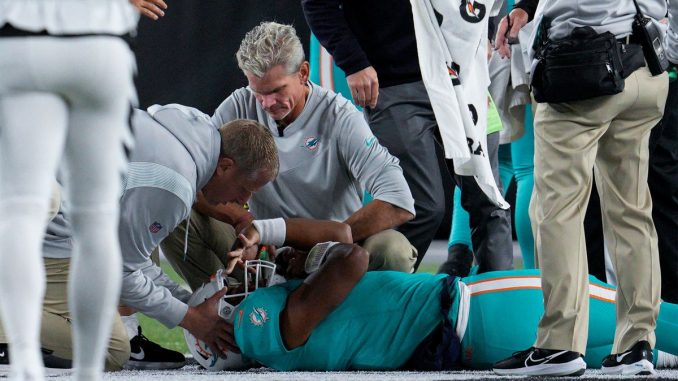
On Sept. 29, the Miami Dolphins and the Cincinnati Bengals game halted as Dolphins quarterback Tua Tagovailoa had to leave the field on a stretcher after hitting his head. The hit came less than a week after he was tackled during the Buffalo Bills’ game on Sept. 25, starting a considerable controversy among football fans and critics alike.
Although Tagovailoa was cleared under the football league’s previous concussion standards, the subsequent injury had to be investigated by the NFL Players Association (NFLPA) due to public outcry on social media.
According to a Twitter post from Tom Pelissero of the NFL Network, the NFL and the NFLPA released a joint statement on Oct. 8 regarding the investigation into the concussion protocol given to Tagovailoa. “The NFL and NFLPA announced that they agreed that concussion protocols were properly applied with Tua Tagovailoa on Sept. 25, but those protocols — now modified — were insufficient.”
The joint statement included background information and context on the NFL-NFLPA Concussion Evaluation and Management Protocol, which was formalized and adopted by the organization in 2013 and has since added many modifications from medical experts to improve the health and safety of its members.
The joint statement concluded that “while the step-by-step process outlined in the Concussion Protocol was followed, the outcome, in this case, was not what was intended when the Protocol was drafted.”
After the initial hit in question, the “Club medical team and the UNC properly engaged in an examination of Tagovailoa before he was cleared to play. The team physician cleared him following consultation with the UNC.” The statement then finalized, “the steps outlined in the Concussion Checklist were, therefore, conducted.”
Although the medical staff concluded that the player’s previous back injury in the game was the cause of instability, this was only diagnosed using previous back examinations. The NFL guidelines do not specify a timeframe for recovery or returning to a game following an impact.
Following Tagovailoa’s controversial return and second dangerous hit during the Bengals game, the NFL and NFLPA added a new term to the mandatory “no-go” symptoms. As stated by NBC Sports, the new term is ataxia, defined as “abnormality of balance/stability, motor coordination or dysfunctional speech caused by a neurological issue.” It joined a list of loss of consciousness, gross motor instability, confusion, amnesia, fencing response, and impact seizure, prohibiting players from returning to the game. The change went in place on Oct. 9, ahead of Week 5 games.
Scrutiny over the handling of this incident is nothing new for the NFL as more and more research continues to show the sport’s negative impacts on its players. Tagovailoa displayed plenty of visual and reactionary signs on the field for both hits. As for the initial tackle against the Bills, Tagovailoa clearly stumbled and struggled to keep himself up. When the second hit happened, he immediately reacted with his hands in an involuntary flexed position, known as the fencing response.
The fencing response stated by a licensed clinical neuropsychologist, April Krowel, Ph.D., in an interview with Men’s Health, “could be experienced whether it’s the first or fifth time. It’s believed that the fencing response is triggered by brain injuries resulting in soft brain tissue hitting the skull’s hard bone.”
“I wouldn’t say it was scary for me at the time because there was a point where I was unconscious, so I couldn’t really tell what was going on,” Tagovailoa said in an interview with ESPN. His recollections immediately after the secondary hit are still unclear to him. Still, he does remember his drive to the University of Cincinnati Medical Center and his trip back to Miami after his discharge.
Repeated head injuries, often experienced by football players, soccer players, and boxers can cause long-term problems like concentration issues, mental health conditions, headaches, physical impairments, and an increased risk for dementia. As stated by the Center for Disease Control and Prevention, these injuries might also cause chronic traumatic encephalopathy (CTE), an incurable brain disease that can only be diagnosed after death. CBS Sports reported that former NFL player, Demaryius Thomas, died at 33 due to this disease.
In the weeks following Tagovailoa’s back-to-back hits, multiple players have left games with head injuries, including New York Giants quarterback Tyrod Taylor and Tennessee Titans running back Nyheim Hines. On Oct. 15, it was reported by ESPN that Tagovailoa was cleared from concussion protocol but would not play in last Sunday’s game against the Minnesota Vikings. The head Dolphins coach, Mike McDaniel, ruled out the quarterback because he wasn’t comfortable making him play after two weeks without any football activity. Tagovailoa is expected to return for Miami’s Week 7 game against the Pittsburgh Steelers on Oct. 23.

